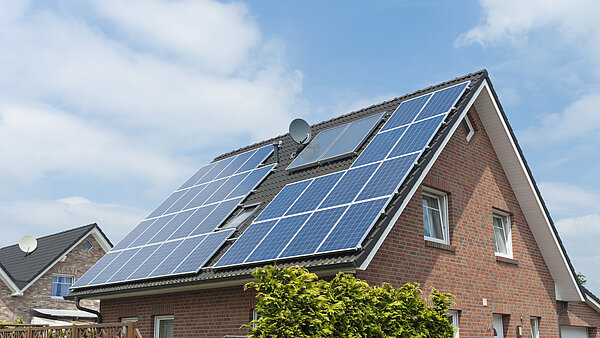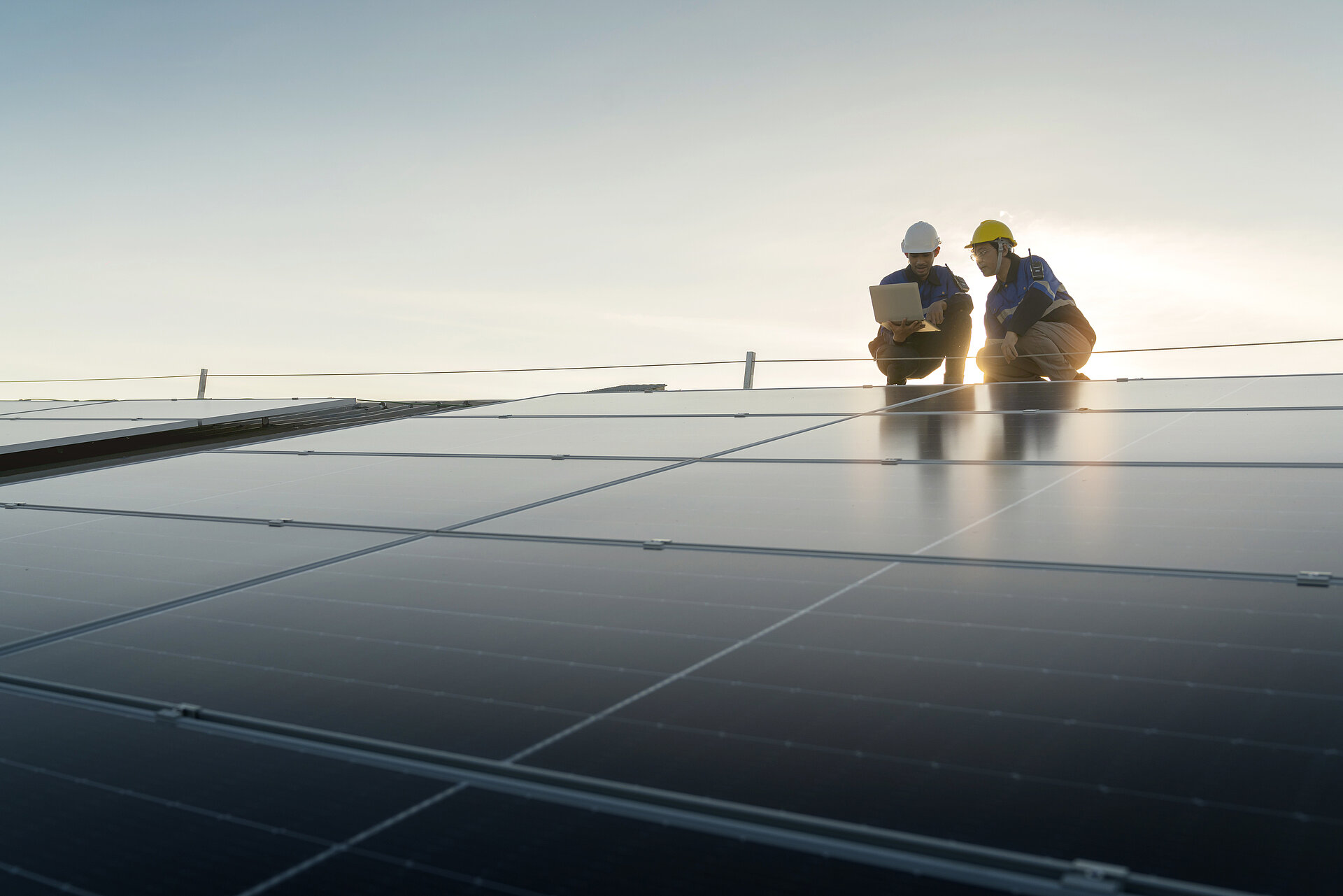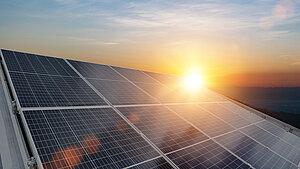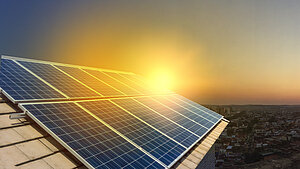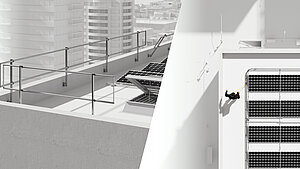Everything starts with a solid plan!
Like any sizeable project, the installation of your PV system on the roof, including a professional and certified fall protection system, starts with professional planning. This is the only way that the available roof surface can be used optimally for power generation – and also be fully legally compliant in terms of the roof’s safety as a workplace. For comprehensive planning, a certain amount of information and data needs to be researched and collected. Basically, on the one hand it is decisive whether the project involves a flat or a pitched roof (inclination greater than 22°, but attention – in Switzerland, inclination greater than 10°).
On the other hand, it is necessary to capture exactly the particular local circumstances and potential “obstacles” on the roof surface, such as skylights, parapets, chimneys, satellite dishes, or a/c equipment, in order to determine the appropriate fall protection system for the PV installation. The roof surface and access options, and even climatic characteristics, also need to be recorded exactly to be able to start the professional planning. On the basis of this data, your solar technician or engineer decides which PV system is optimal for your roof. This also decides the best fall protection system for protecting the PV installation. Not always, but in many cases, the safety system can be attached directly to the substructure of the PV installation.
If you have questions about this, simply contact our experts.
Attention
Viewed in the short term, an improvised and self-assembled safety solution may appear the more affordable option, but in the medium and long term the small additional financial outlay for a professional and certified fall protection system certainly pays for itself. In this way, your solar power plant can be cleaned and serviced at any time, without risking serious accidents or falls. In addition, this ensures that your PV system always provides its full output.
Plan with INNOTECH
The simplest and most certain way to achieve perfect fall protection is through planning by our experts. After reviewing all documentation and key data, they design the optimum safety solution for your PV system, and then provide you with your individual proposal.
Training to become a certified installer of your fall protection system
The functional capability of your fall protection system for the PV installation on your roof depends significantly on the quality of the installation, and also on detailed documentation. The ability to install a professional, certified safety system properly and expertly requires solid training. From a legal viewpoint, it is also essential that not only the installation but also all mandatory annual inspections of the fall protection system are performed exclusively by a certified person. After all, it is essential that the structure is in fact able to withstand the loads resulting from a fall, in order that lives can be saved.
This is why INNOTECH also provides a very extensive training programme through its INNO|school. The training sessions take place mainly in autumn and winter. As a rule, the certificates of competence are valid for 3 years.
Here is an overview of INNOTECH’s training proposals:
- Expert training course – Installation, documentation, inspection, legal principles, planning and documentation of fall protection systems.
- Rescue training – Rescue and stabilisation of victims after a fall.
- PPE training | Class – Use of personal protective equipment (PPE).
- Training for fall protection on PV systems –Theoretical and practical knowledge about the various fall protection systems for PV systems on a roof.
- INNO|training– On the spot training on your construction site.
Simply contact us, if you have additional questions about training in fall protection systems. Our experts will be happy to advise you. Or else download our manual about safety on PV systems now!
It all comes down to a professional installation!
Once the fall protection for the PV system on your roof is planned in detail, it proverbially comes down to what matters – the safety solution is installed on the roof or else directly on the substructure of the PV system. INNOTECH delivers all required parts and materials directly to the construction site for you. The product description and the information material describe exactly the components of the fall protection system, and how they are to be installed. In addition, you can obtain the Mont-Start and Mont-Pro installation cases from us. These toolboxes contain all installation tools for the fall protection system. That saves you, for example, a trip to the hardware store.
Tip: Also use our installation videos. These provide additional assistance for the installation of the fall protection system for the PV installation on your roof. And: We are happy to recommend professional installation partners, if you require.
Duration of installation:
Unfortunately it is not possible to make any generalised statements about the time required for the installation. Too many factors play a role here, such as the choice of the fall protection itself, the PV system and its substructure, and also the roof inclination. Of course, the process can be speeded up by a professional, with the guarantee that everything was installed correctly and effectively. However, as a guideline, you can assume that the installation of a lifeline system with 35 m running length takes about 13 hours. For a 35 m rail system you require about 19 hours.
The acceptance and documentation of your fall protection system
After the installation, the fall protection system must be approved by an expert person – and this must take place in combination with the substructure of the PV system. For this, the entire structure is subject to a thorough inspection. Any defects during installation may cause the fall protection system not to be approved. Full documentation of the installation is a equally legal requirement. For this, every fastening of the fall protection system is recorded by means of photographs.
On the safe side with INNO|doc!
Use our digital documentation tool INNO|doc. That way, this important process runs very simply and smoothly. In addition, fitters and solar technicians can use it to manage all their projects, and they have all data available at the press of a button. The tool also provides a reminder of the annual inspection of the fall protection system – all automatically. Completed documentation can be generated directly from the program as well.
Servicing and inspection of your fall protection system
Because the roof is one of the most dangerous workplaces in any case, safety systems must also be serviced and inspected annually. This is because they are 100% safe only if, firstly, they were installed properly and professionally, and secondly if they are regularly inspected for potential indications of wear and tear, damage or corrosion, and loose fastenings. This too is a legal requirement! For fall protection systems which are frequently exposed to severe stresses such as chemical vapours, etc., the test intervals are even shorter. And: The required inspections too must be documented in appropriate detail – in writing and by means of photos.
What matters for servicing and inspection
In the first place, you should ensure that the installation of your fall protection system is fully documented. If this is not done, then it may mean that the legally required inspection after the first year cannot take place. In an extreme case, this would mean that access to your PV system is forbidden, or that the system would have to be dismantled and re-installed.
Conclude a servicing contract with a certified solar technician or fitter. Ideally with the person who installed the fall protection for the PV system on your roof. That saves time, nerves, and money.In principle TÜV, a civil engineer, or any fitter or solar technician certified by INNOTECH can perform the inspection and servicing.
Here, the following principal items are checked (example: AIO lifeline system):
- Is the roof sealing damaged or corroded?
- Do visible components of the fastenings display deformation or signs of corrosion, and are all threaded joints secured and tightly seated?
- Visual inspection of strands of stainless steel cable
- Is deformation of the intermediate bracket visible? Are the weld seams and all threaded joints in good condition?
- Inspection of the structure and weld seams of the corner and end fastenings
- Check of wedge wraparounds, indicator clamps, cable pre-tension, and welding points (crevice corrosion) of the end locks
- Inspection of threaded joints and slide gap of sliders
- Check whether original INNOTECH carabiners were used
- Check of system functionality
Important: Inspections and servicing tasks on the fall protection system for the PV installation on your roof must also be fully documented, so that you can demonstrate that, at the time of the inspection, the fall protection system was in an optimum state, i.e. it was suitable for use.
Here are the most common defects at a glance:
- Unsuitable fasteners for the respective substructure, or incorrect fastening sets
- Incorrect or insufficient documentation
- Corrosion of individual parts and components
- Loose mounts
If one or more of these defects are found during the inspection, then access to the fall protection system is temporarily blocked. Only when all defects have been corrected – including appropriate documentation – is it possible to release the system again.
An example from practice – ADREX
The correct fall protection provides more space on the roof for the PV system
ADREX Photovoltaikanlagen GmbH has extensive expertise over many years in the planning and installation of PV systems in a wide range of sizes. In order to implement the “one-stop-shop” principle professionally, for fall protection for PV systems, ADREX relies on partners who are able to provide the highest quality and optimum functional capability. For a customer in the northern Schwarzwald, the task was to install a solar power plant on a roof surface of 275 m². For the fall protection, the trained and certified professionals from ADREX selected the AIO lifeline system from INNOTECH, in combination with single anchor points.
The AIO lifeline system
There were several reasons for this decision. One was that this system is mounted directly on the substructure of the PV installation, and damage to the roof cladding can therefore be avoided. Furthermore, the AIO lifeline system is very space-saving, and it therefore permits the optimum use of the roof surface for solar panels. In addition, its design means that there is no shadowing which could reduce the output of the PV system.
In our example
- 25 m stainless steel cable
- 4 single attachment points (EAP)
- Additional EAPs for exposed areas
were installed, so that the customer’s PV system would be safe from the very outset. The planning and design of the fall protection system was implemented by INNOTECH. “As well as the top quality of the fall protection systems, we also decided to collaborate with INNOTECH because of the excellent support and planning”, reports Jan Kaupp, ADREX project manager. Full documentation of the fall protection system’s installation for ADREX’s customer was implemented using the INNO|doc web app.
Image benefit as a full service provider
Since the collaboration with INNOTECH, the image of ADREX as a solar installer has risen significantly, states Jan Kaupp. The reason is that, because they have no professional partners, numerous other solar technicians or installers often plan without a complete safety system, and as a rule the PV system is therefore bound to end up smaller, in order to avoid coming close to the dangerous roof edge. However, a professional fall protection system also provides numerous other advantages, such as absolute legal security. In addition, the PV always provides full output, because the panels can be cleaned and serviced at any time.
Do not wait to contact us for more information! We will team up with you to find the fall protection system that best suits the PV installation on your roof. You will find additional information in our new manual on planning, training, installation and maintenance of fall protection systems for PV installations on a roof.








![[Translate to Englisch:] [Translate to Englisch:]](https://www.innotech-safety.com/fileadmin/_processed_/1/a/csm_Mehrere_PV-Kunden_gleichzeitig_betreuen__kann_oft_zur_Riesenherausforderung_werden-header_c1a520d846.jpg)
















